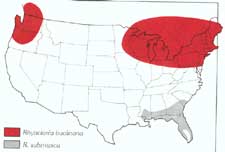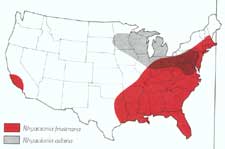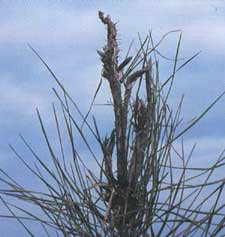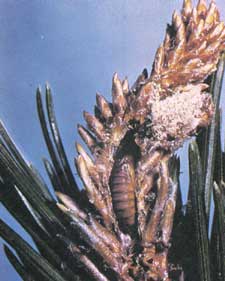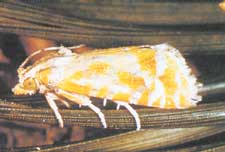Pine Tip MothsWilliam H. Hoffard - Entomologist, Region 8, USDA Forest Service, Asheville, NC. Cordell C.E., Anderson R.L., Hoffard W.H., Landis T.D., Smith R.S. Jr., Toko H.V., 1989. Forest Nursery Pests. USDA Forest Service, Agriculture Handbook No. 680, 184 pp. Hosts Most commercial pine species are attacked by some type of tip moth (family Olethreuidae). The Nantucket pine tip moth (Rhyacionia frustrana) attacks pitch, Virginia, shortleaf, loblolly, and Scotch pines, but longleaf, slash, and white pine are immune. The western pine tip moth (R. bushnelli) prefers ponderosa, Scotch, red, and jack pines. The subtropical pine tip moth (R. subtropica) severely damages slash pine throughout that tree's range. It also attacks longleaf, loblolly, and tropical pines. The European pine shoot moth (R. buolinana) severely damages red pine in the East and ponderosa pine in the Pacific Northwest. Adana pine tip moths (R. adana) prefer red, jack, and Scotch pines. Other species may be destructive but are generally less common. Distribution Figure 25-1 shows the distribution of the European pine shoot moth and the subtropical pine tip moth.
Look for larvae, which range in size from minute to about 10 mm long depending on their age, on needle bases, buds, or within the shoots. Pupae (fig. 25-4), which are compact and usually shiny brown or bronze colored, can be found within dead shoots. Adults, which are seldom seen in nurseries, are usually mottled brick red or yellow (fig. 25-5). Biology The following is a generalized life history for pine tip moths: After overwintering within injured shoots as larvae or pupae (depending on the species), the insects emerge with the arrival of warm weather or during the summer. Soon after they emerge, the new adults mate and deposit eggs at needle bases. At first, newly hatched larvae can only mine needle bases, but as they grow larger, they feed on buds. Eventually they do extensive damage within the shoots. There may be one to six generations per year, depending on the moth species, climate, and location. Very low winter temperatures are often effective in reducing populations of tip moths, particularly northern moth species. Control Cultural - Discourage tip moth attacks by maintaining seedling vigor through proper watering schedules and fertilization. Chemical - A number of insecticides, including diazinon, dimethoate, azinphos-methyl, malathion, and phorate, are registered for use against various tip moths. Proper timing of insecticide application is critical for effective control. Selected References Furniss, R.I.; Carolin. V.M. 1977. Western forest insects. Misc. Publ. 1339. Washington. DC: U.S. Department of Agriculture. Forest Service: 328- 330. Graham, S.A.; Knight F.B. 1965. Principles of forest entomology. New York: McGraw- Hill: 294-297. U.S. Department of Agriculture. Forest Service. 1985. Insects of eastern forests. Misc. PubI. 1426. Washington. DC: U.S. Department of Agriculture. Forest Service. 608 p. |
Forest Pests: Insects, Diseases & Other Damage Agents |

|
|
